
Messier 63 or M63, also known as NGC 5055 or the seldom-used Sunflower Galaxy, is a spiral galaxy in the northern constellation of Canes Venatici with approximately 400 billion stars. M63 was first discovered by the French astronomer Pierre Méchain, then later verified by his colleague Charles Messier on 14 June 1779. The galaxy became listed as object 63 in the Messier Catalogue. In the mid-19th century, Anglo-Irish astronomer Lord Rosse identified spiral structures within the galaxy, making this one of the first galaxies in which such structure was identified.

NGC 4725 is an intermediate barred spiral galaxy with a prominent ring structure, located in the northern constellation of Coma Berenices near the north galactic pole. It was discovered by German-born British astronomer William Herschel on April 6, 1785. The galaxy lies at a distance of approximately 40 megalight-years from the Milky Way. NGC 4725 is the brightest member of the Coma I Group of the Coma-Sculptor Cloud, although it is relatively isolated from the other members of this group. This galaxy is strongly disturbed and is interacting with neighboring spiral galaxy NGC 4747, with its spiral arms showing indications of warping. The pair have an angular separation of 24′, which corresponds to a projected linear separation of 370 kly. A tidal plume extends from NGC 4747 toward NGC 4725.

NGC 7793 is a flocculent spiral galaxy in the southern constellation of Sculptor. It was discovered in 1826 by Scottish astronomer James Dunlop. The galaxy is located at a distance of 12.2 million light years and is receding with a heliocentric radial velocity of 227 km/s. NGC 7793 is one of the five brightest galaxies within the Sculptor Group.
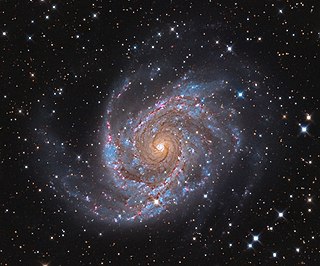
NGC 2997 is a face-on unbarred spiral galaxy about 40 million light-years away in the faint southern constellation of Antlia. It was discovered March 4, 1793 by German-born astronomer William Herschel. J. L. E. Dreyer described it as, "a remarkable object, very faint, very large, very gradually then very suddenly bright middle and 4 arcsec nucleus. This is the brightest galaxy of the NGC 2997 group of galaxies, and was featured on the cover of the first edition of Galactic Dynamics by James Binney and Scott Tremaine.
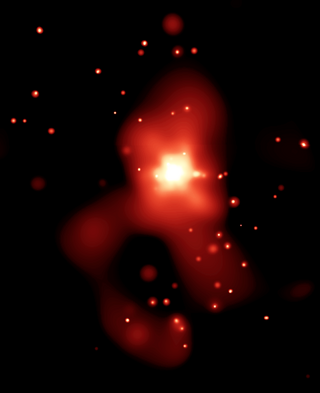
NGC 4261 is an elliptical galaxy located around 100 million light-years away in the constellation Virgo. It was discovered April 13, 1784, by the German-born astronomer William Herschel. The galaxy is a member of its own somewhat meager galaxy group known as the NGC 4261 group, which is part of the Virgo Cluster.

NGC 1566, sometimes known as the Spanish Dancer, is an intermediate spiral galaxy in the constellation Dorado, positioned about 3.5° to the south of the star Gamma Doradus. It was discovered on May 28, 1826 by Scottish astronomer James Dunlop. At 10th magnitude, it requires a telescope to view. The distance to this galaxy remains elusive, with measurements ranging from 6 Mpc up to 21 Mpc.

NGC 4639 is a barred spiral galaxy located in the equatorial constellation of Virgo. It was discovered by German-born astronomer William Herschel on April 12, 1784. John L. E. Dreyer described it as "pretty bright, small, extended, mottled but not resolved, 12th magnitude star 1 arcmin to southeast". This is a relatively nearby galaxy, lying approximately 72 million light-years away from the Milky Way. It is a companion to NGC 4654, and the two appear to have interacted roughly 500 million years ago. NGC 4639 is a member of the Virgo Cluster.

NGC 5371 is a face-on spiral galaxy in the northern constellation Canes Venatici. It was discovered on January 14, 1788 by German-British astronomer William Herschel. The nearby NGC 5390 appears to be a duplicate entry for NGC 5371, since there is nothing at the former's position. NGC 5371 has an apparent magnitude of 11.3 and an angular size of 4.4′ × 3.5′. It is located at a distance of 129.5 ± 32.4 million light-years (39.70 ± 9.92 Mpc) from the Milky Way, and is receding with a heliocentric radial velocity of 2,552 km/s. The galaxy appears to be weakly interacting with the nearby, equidistant Hickson 68 group of galaxies, and thus may be a member. Collectively, they are sometimes dubbed the Big Lick galaxy group, after the city of Roanoke, Virginia.

NGC 5962 is a spiral galaxy in the equatorial constellation of Serpens Caput. It was discovered by the Anglo-German astronomer William Herschel on March 21, 1784. The NGC 5962 galaxy is located at a distance of 120 million light years and is receding with a heliocentric radial velocity of 1,957 km/s. It is the brightest member of the eponymously-named NGC 5962 group, which overlaps with the nearby NGC 5970 group; the two groups may be gravitationally bound.
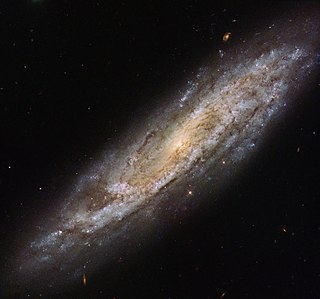
NGC 2770 is a spiral galaxy in the northern constellation of Lynx, near the northern constellation border with Cancer. It was discovered by German-born astronomer William Herschel on December 7, 1785. J. L. E. Dreyer described it as, "faint, large, much extended 150°, mottled but not resolved, 2 stars to north". NGC 2770 was the target for the first binocular image produced by the Large Binocular Telescope.

NGC 5584 is a barred spiral galaxy in the constellation Virgo. It was discovered July 27, 1881 by American astronomer E. E. Barnard. Distance determination using Cepheid variable measurements gives an estimate of 75 million light years, whereas the tip of the red-giant branch approach yields a distance of 73.4 million light years. It is receding with a heliocentric radial velocity of 1,637 km/s. It is a member of the Virgo III Groups, a series of galaxies and galaxy clusters strung out to the east of the Virgo Supercluster of galaxies.

NGC 2397 is a flocculent spiral galaxy located in the southern Volans constellation, about one degree to the SSE of Delta Volantis. English astronomer John Herschel discovered the galaxy on February 21, 1835. It is located at a distance of approximately 69 million light years from the Sun, and is a member of the small NGC 2442 group that includes NGC 2434.

NGC 4030 is a grand design spiral galaxy located about 64 million light years away in the constellation Virgo. It is a member of the NGC 4030 Group of galaxies, which is a member of the Virgo II Groups, a series of galaxies and galaxy clusters strung out from the southern edge of the Virgo Supercluster. With an apparent visual magnitude of 10.6, it is visible with a small telescope as a 3 arc minute wide feature about 4.75° to the southeast of the star Beta Virginis. It is inclined by an angle of 47.1° to the line of sight from the Earth and is receding at a velocity of 1,465 km/s.

NGC 4451 is a spiral galaxy in the equatorial Virgo constellation. It was discovered at the Copenhagen Observatory on March 19, 1865, by Heinrich d'Arrest, who used an 11" refractor telescope. The galaxy is located at a distance of 85 million light years and is receding with a heliocentric radial velocity of 862 km/s. It is a member of the Virgo cluster of galaxies.
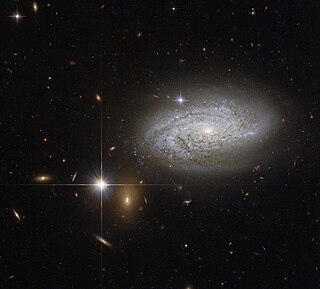
NGC 3021 is a spiral galaxy in the northern constellation of Leo Minor. It is about 93 million light-years away from Earth, and is receding with a heliocentric radial velocity of 1,537±4 km/s. This galaxy was discovered December 7, 1785 by Anglo-German astronomer William Herschel. The morphological classification of NGC 3021 is SA(rs)bc, which indicates a spiral galaxy with no central bar (SA), an incomplete inner ring structure (rs), and moderate to loosely wound spiral arms (bc).
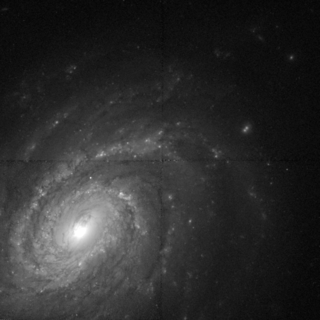
NGC 214 is a spiral galaxy in the northern constellation of Andromeda, located at a distance of 194 megalight-years from the Milky Way. It was discovered on September 10, 1784 by William Herschel. The shape of this galaxy is given by its morphological classification of SABbc, which indicates a weak bar-like structure (SAB) at the core and moderate to loosely-wound spiral arms (bc).

NGC 5917 is a spiral galaxy located in the constellation of Libra. It was discovered by English astronomer John Herschel on 16 July 1835. This galaxy is located at a distance of 90.4 ± 6.2 million light-years (27.73 ± 1.90 Mpc) from the Milky Way, and is receding with a heliocentric radial velocity of 1,934.1 km/s. It is interacting with the neighboring galaxy, PGC 54817, at an angular separation of 4.2′. Tidal tails extend from PGC 54817 to the halo of NGC 5917.

NGC 4302 is an edge-on spiral galaxy located about 55 million light-years away in the constellation Coma Berenices. It was discovered by astronomer William Herschel on April 8, 1784 and is a member of the Virgo Cluster.

NGC 3294 is a spiral galaxy in the constellation Leo Minor. It was discovered by William Herschel on Mar 17, 1787. It is a member of the Leo II Groups, a series of galaxies and galaxy clusters strung out from the right edge of the Virgo Supercluster. The galaxy is located at a distance of 98 million light years and is receding with a heliocentric radial velocity of 1,586 km/s. The morphological class of NGC 3294 is SA(rs)bc, which means this is a spiral galaxy with no central bar (SA), an incomplete inner ring structure (rs), and moderately wound spiral arms (bc).

NGC 1325 is a flocculent spiral galaxy situated in the constellation of Eridanus. Located about 75 million light years away, it is a member of the Eridanus cluster of galaxies, a cluster of about 200 galaxies. It was discovered by William Herschel on 19 December 1799.




















